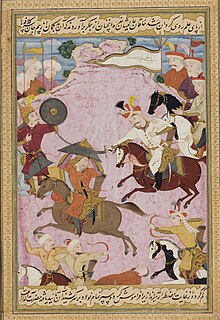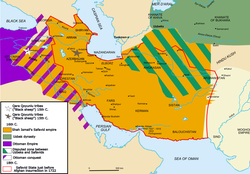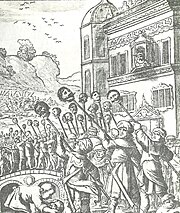Safavid Empire
| 1501–1722/1736 | |||||||||
 Greatest borders during Abbas the Great | |||||||||
| Capital | Tabriz (1501–1555) Qazvin (1555–1598) Isfahan (1598–1736) | ||||||||
| Official languages | Persian[3] Azerbaijani(palace and army) | ||||||||
| Religion | Twelver Shia Islam (official) | ||||||||
| Government | Monarchy | ||||||||
| Shah | |||||||||
• 1501–1524 | Ismail I(first) | ||||||||
• 1732–1736 | Abbas III (last) | ||||||||
| History | |||||||||
• Establishment of the Safavid order by Safi-ad-din Ardabili | 1301 | ||||||||
• Established | 1501 | ||||||||
• Hotak invasion | 1722 | ||||||||
• Reconquest under Nader Shah | 1726–1729 | ||||||||
• Disestablished | 8 March 1722/1736 | ||||||||
• Nader Shah crowned | 8 March 1736 | ||||||||
| Currency | Tuman, Abbasi (incl. Abazi)
| ||||||||
| |||||||||
The Safavid Iran or the Safavid Empire (Persian: شاهنشاهی صفوی, romanized: Šāhanšāhi-ye Safavi) was an early modern Iranian empire.[4]
The Safavids ruled from 1501 to 1722 (experiencing a brief restoration from 1729 to 1736 and 1750 to 1773) and, at their height, they controlled all of what is now Iran, Republic of Azerbaijan, Bahrain, Armenia, eastern Georgia, parts of the North Caucasus including Russia, Iraq, Kuwait, and Afghanistan, as well as parts of Turkey, Syria, Pakistan, Turkmenistan, and Uzbekistan.
Origin and language[change | change source]
Originally of Turkic origin,[5] which began as a Sunni mystical order,[6] which was non-tribal,[7][4] the Safavids emerged as a hereditary lineage of Sufi sheiks centred in Ardabil, belonging to the Shafi'i school and of Turkic origin.[8] The Safavid shahs spoke Azeri brand of Turkic at the court like the qizilbash,[9]. After the capital was moved to Isfahan, Persian began to be spoken in the palace.
History[change | change source]

Safavid conquest of Iran[change | change source]
In the summer of 1500, Ismail (member of Safavid family), rallied about 7,000 Qizilbash troops at Erzincan, including members of the Ustajlu, Rumlu, Takkalu, Dhu'l-Qadar, Afshar, Qajar, and Varsaq tribes.[10] Thus, the Safavids launched a new Turkic invasion from the east.[8] Qizilbash forces passed over the Kura River in December 1500, and marched towards the Shirvanshah's state. They defeated the forces of the Shirvanshah Farrukh Yassar near Cabanı (present-day Shamakhi Rayon, Azerbaijan Republic)[11] or at Gulistan (present-day Gülüstan, Goranboy, Nagorno-Karabakh),[12][13] and subsequently went on to conquer Baku.[13]

Thus, Shirvan and its dependencies (up to southern Dagestan in the north) were now Ismail's. The successful conquest had alarmed the ruler of the Aq Qoyunlu, Alvand, who subsequently proceeded north from Tabriz, and crossed the Aras River in order to challenge the Safavid forces, and both sides met at the battle of Sharur in which Ismail's army came out victorious despite being outnumbered by four to one.[13] He also made an alliance with the Kurds of Dersim,[14] even though he had bad relations with other Kurds. The Safavid dynasty rose to power in 1501, when Ismail I took the city of Tabriz from the Aq Qoyunlu Turkomans and proclaimed himself the Shah of Iran.[15] He appointed his former guardian and mentor Husayn Beg Shamlu as the vakil (vicegerent) of the empire and the commander-in-chief (amir al-umara) of the Qizilbash army.
Revival of Iranianhood and spread of Shi'ism[change | change source]
The reign of Ismail I is one of the most important in the history of Iran. The reasons for this are twofold. Firstly, before his accession in 1501, Iran, since its conquest by the Arabs eight-and-a-half centuries earlier, had not existed as a unified country under native Iranian rule, but had been controlled by a series of Arab caliphs, Turkic sultans, and Mongol khans.[10][16] Although many Iranian dynasties rose to power amidst this whole period, it was only under the Buyids that a vast part of Iran properly returned to Iranian rule (945–1055). Secondly, one of his first acts, the promulgation of the Eṯnā-ʿašarī rite of Shiʿism to be the official religion of the newly-created state, had profound consequences for the subsequent history of Iran.[10]

After the Ismail I[change | change source]
In the reign of Tahmasb I, Suleiman the Magnificent (r. 1520–1566), sultan of the Ottoman Empire, may have considered a strong Safavid empire a threat to his ambitious plans in the west and northwest of his realm. During the first decade of Tahmasp's reign, however, he was preoccupied with fighting the Habsburgs and the unsuccessful attempt to seize Vienna.[17] In 1532, while the Ottomans were fighting in Hungary, Suleiman sent Olama Beg Takkalu with 50,000 troops under Fil Pasha to Iran. The Ottomans seized Tabriz and Kurdistan, and tried to obtain support from Gilan province.[18] Tahmasp drove the Ottomans out, but news of another Uzbek invasion prevented him from defeating them.[19] Suleiman sent his grand vizier, Ibrahim Pasha, to occupy Tabriz in July 1534 and joined him two months later.[17] Suleiman peacefully conquered Baghdad and Shia cities such as Najaf.[18] Whilst the Ottomans were on the march, Tahmasp was in Balkh, campaigning against the Uzbeks.[19] Tahmasp did not fight the exhausted Ottoman army but laid waste the entire region from Tabriz to the frontier; the Ottomans could not permanently occupy the captured lands, since they soon ran out of supplies.[20] Tahmasp established a new polity for the Safavid state; he decreased the Qizilbash influence on the Iranian bureaucracy.[21]

Ismail II reigned for one year[22] and was replaced by Mohammad Khodabanda. At the time of Mohammad Khodabanda, oreign powers took advantage of the factional discord in Iran court to seize territory for themselves. Uzbek bands attempted to invade north-east Iran before being repulsed by the governor of Mashhad. The most important event of Khodabanda's reign was the war with the Ottomans. In 1578, the Ottoman sultan Murad III began a war with Safavid Iran which was to last until 1590. In the first attack, the sultan's vizier Lala Mustafa Pasha invaded the Safavid territories comprising Georgia and Shirvan. Shirvan fell before the end of the summer of 1578, by which fact the Ottomans had now control of almost all territories west of the Caspian Sea coast, and it also opened the way for an attack on what is nowadays the core of Armenia and Azerbaijan, which were subsequently attacked in 1579 by a large contingent of Crimean Tatars, led by Adil Giray Khan,[23] but he was captured in a remarkable counterattack led by Mirza Salman Jabiri and Hamza Mirza, and later executed in Qazvin, the Safavid capital at that time.
Reconquest[change | change source]

Copper engraving by Dominicus Custos, from his Atrium heroicum Caesarum pub. 1600–1602.
Against the Uzbeks
His successor, Abbas I, initiated a Reconquest, with the Uzbeks invading Khorasan first. By 1599, Abbas had conquered not only Herat and Mashhad, but had moved as far east as Balkh. This would be a short-lived victory and he would eventually have to settle on controlling only some of this conquest after the new ruler of the Khanate of Khiva, Baqi Muhammad Khan attempted to retake Balkh and Abbas found his troops were still no match for the Uzbeks. By 1603, the battle lines had stabilized, albeit with the loss of the majority of the Persian artillery. Abbas was able to hold onto most of Khorassan, including Herat, Sabzevar, Farah, and Nisa.[24]
Abbas' north-east frontier was now safe for the time being and he could turn his attention to the Ottomans in the west.[25] After defeating the Uzbeks, he moved his capital from Qazvin to Isfahan.
Against the Ottomans

He then fought against the Ottomans and aptured northern Iran even in 1623, Abbas decided to take back Mesopotamia, which had been lost by his grandfather Tahmasp through the Ottoman-Safavid War (1532–1555).[26] Profiting from the confusion surrounding the accession of the new Ottoman Sultan Murad IV, he pretended to be making a pilgrimage to the Shi'ite shrines of Kerbala and Najaf, but used his army to seize Baghdad.[27] However, Abbas was then distracted by a rebellion in Georgia in 1624 led by Giorgi Saakadze thus allowing an Ottoman force to besiege Baghdad, but the Shah came to its relief the next year and crushed the Turkish army decisively.[28] In 1638, however, after Abbas' death, the Ottomans retook Baghdad, and the Iranian–Ottoman border was finalised to be roughly the same as the current Iran–Turkey and Iran–Iraq borders.
Fall[change | change source]
Safavids eventually succumbed to Russian, Afghan and Ottoman pressure and was replaced by Afsharids.
Safavid Shahs of Iran[change | change source]
References[change | change source]
- ↑ Matthee 2009, p. 241.
- ↑ Savory 2007, p. 206.
- ↑ Roemer 1986, p. 331.
- ↑ 4.0 4.1 Matthee 2008.
- ↑ • Amoretti & Matthee 2009: "Of Kurdish ancestry, the Ṣafavids started as a Sunnī mystical order (...)"
• Matthee 2005, p. 18: "The Safavids, as Iranians of Kurdish ancestry and of nontribal background, did not fit this pattern, although the stat they set up with the aid of Turkmen tribal forces of Eastern Anatolia closely resembled this division in its makeup. Yet, the Turk versus Tajik division was not impregnable."
• Matthee 2008: "As Persians of Kurdish ancestry and of a non-tribal background, the Safavids did not fit this pattern, though the state they set up with the assistance of Turkmen tribal forces of eastern Anatolia closely resembled this division in its makeup."
• Savory 2008, p. 8: "This official version contains textual changes designed to obscure the Kurdish origins of the Safavid family and to vindicate their claim to descent from the Imams."
• Hamid 2006, p. 456–474: "The Safavids originated as a hereditary lineage of Sufi shaikhs centered on Ardabil, Shafeʿite in school and probably Kurdish in origin."
• Amanat 2017, p. 40 "The Safavi house originally was among the landowning nobility of Kurdish origin, with affinity to the Ahl-e Haqq in Kurdistan (chart 1). In the twelfth century, the family settled in northeastern Azarbaijan, where Safi al-Din Ardabili (d. 1334), the patriarch of the Safavid house and Ismail's ancestor dating back six generations, was a revered Sufi leader."
• Tapper 1997, p. 39: "The Safavid Shahs who ruled Iran between 1501 and 1722 descended from Sheikh Safi ad-Din of Ardabil (1252–1334). Sheikh Safi and his immediate successors were renowned as holy ascetics Sufis. Their own origins were obscure; probably of Kurdish or Iranian extraction, they later claimed descent from the Prophet." - ↑ Amoretti & Matthee 2009.
- ↑ Matthee 2005, p. 18.
- ↑ 8.0 8.1 Hamid 2006, p. 456–474.
- ↑ Savory 1980, p. 213.
- ↑ 10.0 10.1 10.2 Savory & Karamustafa 1998, p. 628–636.
- ↑ Roemer 1986, p. 211.
- ↑ Roy 2014, p. 44.
- ↑ 13.0 13.1 13.2 Sicker 2000, p. 187.
- ↑ Dersimi 1952, p. 74.
- ↑ Roemer 1986, p. 212.
- ↑ Savory 1980, p. 3.
- ↑ 17.0 17.1 Roemer 1986, p. 241.
- ↑ 18.0 18.1 Newman 2008, p. 28.
- ↑ 19.0 19.1 Mitchell 2009.
- ↑ Savory & Bosworth 2012.
- ↑ Roemer 2008, p. 249; Khafipour 2021, p. 121
- ↑ Ghereghlou 2016.
- ↑ Sicker 2001, pp. 2–3.
- ↑ Roemer 1986, p. 267.
- ↑ Savory 1980, p. 84.
- ↑ Bomati & Nahavandi 1998, pp. 157–158.
- ↑ Bomati & Nahavandi 1998, p. 158.
- ↑ Bomati & Nahavandi 1998, pp. 158–159.
Sources[change | change source]
- Matthee, Rudi (2008). "SAFAVID DYNASTY". Encyclopædia Iranica.
- Sicker, Martin (2000). The Islamic World in Ascendancy: From the Arab Conquests to the Siege of Vienna. Greenwood Publishing Group. ISBN 978-0275968922.
- Hamid, Algar (2006). "IRAN ix. RELIGIONS IN IRAN (2) Islam in Iran (2.3) Shiʿism in Iran Since the Safavids". Encyclopaedia Iranica, Vol. XIII. Fasc. 5. pp. 456–474.
- Matthee, Rudi (1 September 2009). "Was Safavid Iran an Empire". Journal of the Economic and Social History of the Orient. 53 (1): 241. doi:10.1163/002249910X12573963244449. S2CID 55237025.
- Newman, Andrew J. (2008). Safavid Iran: Rebirth of a Persian Empire. New York: I.B.Tauris. ISBN 9780857716613.
- Bomati, Yves; Nahavandi, Houchang (1998). Shah Abbas, Empereur de Perse: 1587–1629 [Shah Abbas, Emperor of Persia: 1587–1629] (in French). Paris, France: Perrin. ISBN 2-2620-1131-1. LCCN 99161812.
- Roy, Kaushik (2014). Military Transition in Early Modern Asia, 1400–1750: Cavalry, Guns, Government and Ships. Bloomsbury Publishing. ISBN 978-1780938004.
- Roger Savory (2 January 2007). "The Safavid state and polity". Iranian Studies. 7 (1–2): 206. doi:10.1080/00210867408701463.
- Savory, Roger M.; Bosworth, C.E. (2012). "Ṭahmāsp". In Fleet, Kate; Krämer, Gudrun; Matringe, Denis; Nawas, John; Stewart, Devin (ed.). Encyclopaedia of Islam, THREE. Brill. ISSN 1873-9830.
{{cite encyclopedia}}: CS1 maint: multiple names: editors list (link) - Savory, Roger (1980). Iran under the Safavids. Cambridge University Press. ISBN 0-521-22483-7.
- Amoretti, Biancamaria Scarcia; Matthee, Rudi (2009). "Ṣafavid Dynasty". In Esposito, John L. (ed.). The Oxford Encyclopedia of the Islamic World. Oxford University Press.
- Ghereghlou, Kioumars (2016). "Esmāʿil II". Encyclopædia Iranica.
- Dersimi, Nuri (1952). Kürdistan Tarihinde Dersim (in Turkish). Aleppo: Ani Matbaası. ISBN 975-6876-44-1.
- Matthee, Rudi (2005). The Pursuit of Pleasure: Drugs and Stimulants in Iranian History, 1500-1900. Princeton Universty Press. ISBN 978-1-4008-3260-6.
- Tapper, Richard (1997). Frontier Nomads of Iran: A Political and Social History of the Shahsevan. Cambridge University Press. p. 39. ISBN 978-0521583367.
The Safavid Shahs who ruled Iran between 1501 and 1722 descended from Sheikh Safi ad-Din of Ardabil (1252–1334). Sheikh Safi and his immediate successors were renowned as holy ascetics Sufis. Their own origins were obscure; probably of Kurdish or Iranian extraction, they later claimed descent from the Prophet.
- Roemer, H. R (1986). "The Safavid Period". In Fisher, William Bayne; Avery, P.; Hambly, G.R.G.; Melville, C. (ed.). The Cambridge History of Iran. Vol. 6: The Timurid and Safavid Periods. Cambridge University Press. ISBN 0-521-20094-6.
{{cite book}}: CS1 maint: multiple names: editors list (link) - Amanat, Abbas (2017). Iran: a Modern History. Yale University Press. pp. 40. ISBN 9780300231465.
- Savory, Roger (2008). "EBN BAZZĀZ". Encyclopædia Iranica. Vol. VIII. Fasc. 1. p. 8.
- Khafipour, Hani (2021). "Beyond Charismatic Authority: The crafting of a Sovereign's Image in the Public Sphere". In Matthee, Rudi (ed.). The Safavid World. New York: Taylor & Francis. ISBN 9781000392876.
- Mitchell, Colin P (2009). "Tahmāsp I". In Yarshater, Ehsan (ed.). Encyclopædia Iranica.













